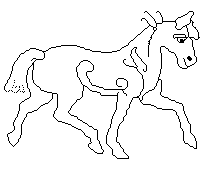
THE PICTS IN REVIEW
Why bother writing about the Picts? They did not even call themselves "the Picts". No body of evidence seems to have been written by them to describe their legends, their culture, their laws, their beliefs, their battles or their daily life. What facts are known about them? If you are looking for some explanation for the occurrence of red hair amongst the Rosses, you need not explore any further than the Picts. [Ref: Roman historian Tacitus] The dirk and targe originated during their Bronze Age. During the time of Robert the Bruce, the Earl of Ross maintained a fleet of galleys, and most of the red-haired Rossmen carried these weapons. [Ref: Nigel Trantor, Robert the Bruce: The Path of the Hero King, pp 56-62.] Their non-Celtic form of inheritance of the kingship was from the matrilineal royal lines. This system of tanistry was adopted by the Scots, when it suited their purposes, as the preferred method of succession to the throne. [Ref: Bede and others] However, they added a new dimension. The element of killing off one's competition was introduced through Kenneth I, son of Alpin, and was perpetuated by subsequent rulers from Dalraida. This early "Scottish custom" was made to appear weird and wild by the genius of William Shakespeare in his play about Macbeth, a Mormaer of Moray, who killed Duncan I to become King from 1040 to 1057. Although Pictish kings could rule anywhere between Moray and Argyll, the royal seat was established at Scone from the earliest times. They named places such as Skye, Lewis and Caithness. [The legendary first Pictish king Cruithne, son of Cing(e), ruled 100 years. Caithness was so named either from one of his alleged seven sons: Fib, Fidach, Foltaig, Fortrenn, Cait, Ce and Circinn (who gave their names to their seven sub-kingdoms) and/or from Caitt, referring to the large cats which were allegedly still alive in the area early in the first century.] The Picts defied and eventually defeated Rome ... never to be conquered by them. However, we owe a debt of gratitude to the Roman, Tacitus, for the first solid paragraphs of Scottish history. The Picts were among the first peoples to enter the Iron Age (circa 500 BC), and they were the first to use the metre-long sword in battle. The Picts were dominated by a warrior-aristocracy. As such, they mastered the skills of offence and defence. Evidence of the latter may be found at populous coastal sites, where hill-forts (e.g.- Cnoc an Duin near Scotsburn west of Tain) and drystone towers or brochs (e.g.- Dun Alascaig near Easter Ross overlooking the Dornoch Firth) may be found. In addition, it has been noted that the Romans feared the Pictish Navy. An early King Bridei of the Picts (554-584 AD) defeated King Gabran of the Scots and laid waste to Scottish holdings in Dalraida. Had he pressed on and expelled the Scots from Argyll, the country of Scotland might still be Pictland or Alba today. As the kingdom of Alba developed during the transition from Pictland to Scotland, the concept of the seven Pictish provinces or sub-kingdoms persisted, and each sub-king (Righ and Mormaer or "steward of the sea") was responsible to the high king (Ard-Righ). Between the mid-ninth century and the mid-twelfth century the seven ancient sub-kingdoms survived as Angus, Athol (derived from "Foltaig"), Strathearn, Fife (from "Fib"), Mar, Moray and Caithness (from "Cait"). Rebellious Moray was forfeited to the crown in 1134 and its territory of Ross was established in 1160 as a separate earldom under Malcolm Macbeth, the first Earl of Ross and one of the "seven Maister Men of Scotland". Rosalind Mitchison, in A History of Scotland, 1970, wrote on page 13:
Since Pictland was composed of seven districts, each ruled by related royal families, the concept of a leader being King of the people (rather than of the land) was born. [e,g.- Mary was "Queen of Scots" just as a chief was the leader of the clan. Under Norman influence, many clan chiefs later forgot or ignored this trust which their people held.] The art on their Symbol Stones was unique, perhaps rivalled only by the stonework of the Norse. [The straight-line characters of Ogham and Futhark merit comparison as well.]  As sailors, they knew the outline of their eastern peninsula in the shape of the head of a horse. The Teutonic name, Ross, was very likely in their pre-Celtic Ogham and P-Celtic vocabularies.
As sailors, they knew the outline of their eastern peninsula in the shape of the head of a horse. The Teutonic name, Ross, was very likely in their pre-Celtic Ogham and P-Celtic vocabularies.They had a concept of eternity and the infinite. The unending interlacing geometric designs on their Symbol Stones are proof of this. After 30 years of patience and restraint following repeated battles as far north as Inverness, the Picts finally butchered the Teutonic armies of the Anglo-Saxons who occupied their southern lands. The slaughter took place on May 20, 685 AD, at Nechtansmere in Angus. Had this later King Bridei lost, the whole of Scotland might have been English. The concept of a "duthus" as a sacred clan centre was an early tradition in Ross. The church of St. Duthac (Dhubthaich or Duthus) was greatly revered. King Malcolm III Canmore of Scots, who ruled from 1057 to 1093 (after Macbeth), proposed that clan chiefs be named from (or give their names to) their duthus. As the clan system became strengthened under his rule, Alba was replaced by Scotland. |





